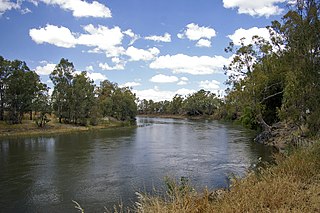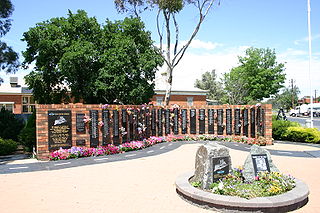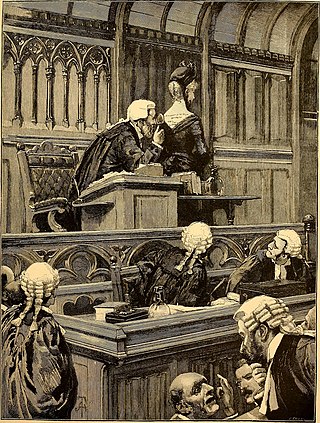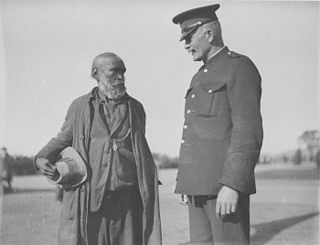
The Murrumbidgee River is a major tributary of the Murray River within the Murray–Darling basin and the second longest river in Australia. It flows through the Australian state of New South Wales and the Australian Capital Territory, descending 1,500 metres (4,900 ft) over 1,485 kilometres (923 mi), generally in a west-northwesterly direction from the foot of Peppercorn Hill in the Fiery Range of the Snowy Mountains towards its confluence with the Murray River near Boundary Bend.

Snowy Mountains Highway is a 333-kilometre-long (207 mi) state highway located in New South Wales, Australia. Its two sections connect the New South Wales South Coast to the Monaro region, and the Monaro to the South West Slopes via the Snowy Mountains. The higher altitude regions of this road are subject to snow over the winter months, and the road also provides access to many parts of the Snowy Mountains Scheme. The highway bears the B72 shield along its entire length.

Gundagai is a town in New South Wales, Australia. Although a small town, Gundagai is a popular topic for writers and has become a representative icon of a typical Australian country town. Located along the Murrumbidgee River and Muniong, Honeysuckle, Kimo, Mooney Mooney, Murrumbidgee and Tumut mountain ranges, Gundagai is 390 kilometres (240 mi) south-west of Sydney. Until 2016, Gundagai was the administrative centre of Gundagai Shire local government area. In the 2021 census, the population of Gundagai was 2,057.

Group 9 is a rugby league competition based in Wagga Wagga, New South Wales, Australia, and surrounding areas. The competition is played in six grades, with these being Under 16s, Under 18s, Women's Tackle, Women's League-Tag, Reserve-Grade and First-Grade.

Tarcutta is a town in south-western New South Wales, Australia. The town is 438 kilometres (272 mi) south-west of Sydney, 3 kilometres (1.9 mi) east of the Hume Highway, It was proclaimed as a village on 28 October 1890. As of 2016, the town had a population of 446.

Tumut is a town in the Riverina region of New South Wales, Australia, situated on the banks of the Tumut River.
The Clayton Cup is a trophy that was awarded by the Country Rugby League to the NSW country rugby league team with the best overall record for that season. To be eligible, the team must win the highest level of competition in its region. Usually the winner of the Clayton Cup goes through the season undefeated. In late 2019, the Country Rugby League was absorbed by the New South Wales Rugby League.

Tumblong is a village community in the central east part of the Riverina and situated about 18 kilometres (11 mi) south east from Mundarlo and 25 kilometres (16 mi) northwest of Adelong. It was known as Adelong Crossing or Adelong Crossing Place until 1913. At the 2011 census, Tumblong and the surrounding area had a population of 338.
Wynyard was an electoral district for the Legislative Assembly in the Australian State of New South Wales from 1904 to 1913, including the town of Tumut and named after Wynyard County. It replaced all of the abolished district of Tumut and part of the abolished district of Gundagai. Its only member was Robert Donaldson. The Federal Capital Territory was removed from New South Wales in 1911 and Wynyard was abolished in the 1912 redistribution. Most of the district, including the town of Tumut was absorbed by the district of Yass and the balance was distributed between the surrounding districts of Cootamundra, Wagga Wagga and Albury.

The Tumut and Kunama railway lines are disused railway lines in the south of New South Wales, Australia. The Tumut line was a 104 kilometres (65 mi) long branch of the Main South line, branching southwards from it at Cootamundra and heading to the town of Tumut. The line served the towns of Tumut and Gundagai, where the line crosses the Murrumbidgee River with a large iron girder bridge and wooden viaduct. Villages on the line included Brawlin, Muttama, Coolac and Tumblong.

The Wagga Wagga Express and Murrumbidgee District Advertiser was an English language newspaper published in Wagga Wagga, New South Wales. It was the first newspaper to be published in Wagga Wagga, and was in circulation from 1858 to 1939.

The Tumut and Adelong Times and Batlow District News is an English language newspaper currently published in Tumut, New South Wales. It was first published as The Tumut and Adelong Times and has absorbed Adelong and Tumut Express and Batlow District News, Tumut-Batlow-Adelong District News, The Tumut Advocate and Farmers & Settlers' Adviser and The Adelong Argus, Tumut and Gundagai Advertiser.

The Gundagai Independent is a newspaper published in Gundagai, New South Wales, Australia since 1898. It was previously published as The Gundagai Independent and Pastoral, Agricultural and Mining Advocate.

Mr Meeson's Will is an 1888 novel by H. Rider Haggard. It was based on a well known anecdote of the time. The plot concerns a marooned man's will tattooed on the back of a woman.
The Adelong Creek, a perennial river that is part of the Murrumbidgee catchment within the Murray–Darling basin, is located in the South West Slopes, and Riverina regions of New South Wales, Australia.
Thomas Frederic De Courcy Browne was an Irish-born Australian politician and journalist.
Whyman McLean was an Aboriginal Australian man, a religious missionary who later served as an Aboriginal tracker in the New South Wales Police Force for thirty years until his retirement in 1925.
The Burrangong Argus was an Australian newspaper based in Young, New South Wales, published twice-weekly from 1865 to 1913. It was, at the time of its closure, the oldest newspaper in Young. It sold at 6d per copy, then 3d per copy and finally 1d per copy, as it attempted to compete with later rivals the Young Chronicle and Young Witness.

George John Noble was an Aboriginal elder from the Wiradjuri tribe in Australia. He was born at Muttama Station in New South Wales and lived intermittently at Gundagai while travelling across the Riverina, the Central and Southern Tablelands, the South Coast and Greater Sydney regions. Noble obtained the nickname Marvellous due to his regular use of the word in conversation.
Reno is a rural locality in the Cootamundra–Gundagai Regional Council local government area of the Riverina region, of New South Wales, Australia. There was once a gold mining village of the same name. For many years, until at least 2016, the locality was known as Jones Creek. Its population at the 2021 census was 131.













